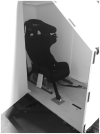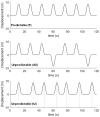Knowing What's Coming: Unpredictable Motion Causes More Motion Sickness
- PMID: 31590575
- PMCID: PMC7672670
- DOI: 10.1177/0018720819876139
Knowing What's Coming: Unpredictable Motion Causes More Motion Sickness
Abstract
Objective: This study explores the role of anticipation in motion sickness. We compared three conditions varying in motion predictability and assessed the effect of anticipation on subsequent illness ratings using a within-subjects design.
Background: Anticipation is thought to play a role in motion sickness by reducing the discrepancy between sensed and expected sensory information. However, both the exact role and potential magnitude of anticipation on motion sickness are unknown.
Method: Participants (N = 17) were exposed to three 15-min conditions consisting of repeated fore-aft motion on a sled on a 40-m rail (1) at constant intervals and consistent motion direction, (2) at constant intervals but varied motion direction, and (3) at varied intervals but consistent motion direction. Conditions were otherwise identical in motion intensity and displacement, as they were composed of the same repetitions of identical blocks of motion. Illness ratings were recorded at 1-min intervals using an 11-point motion sickness scale.
Results: Average illness ratings after exposure were significantly lower for the predictable condition, compared with both the directionally unpredictable condition and the temporally unpredictable condition.
Conclusion: Unpredictable motion is significantly more provocative compared with predictable motion. Findings suggest motion sickness results from a discrepancy between sensed and expected motion, rather than from unpreparedness to motion.
Application: This study underlines the importance of an individual's anticipation to motion in motion sickness. Furthermore, this knowledge could be used in domains such as that of autonomous vehicles to reduce carsickness.
Keywords: attentional processes; autonomous driving; motion sickness; multisensory integration.
Figures






References
-
- Bles W., Bos J. E., de Graaf B., Groen E., Wertheim A. H. (1998). Motion sickness: Only one provocative conflict? Brain Research Bulletin, 47, 481–487. - PubMed
-
- Bos J. E., Bles W. (2002). Theoretical considerations on canal-otolith interaction and an observer model. Biological Cybernetics, 86, 191–207. - PubMed
-
- Bos J. E., Bles W., Groen E. L. (2008). A theory on visually induced motion sickness. Displays, 29, 47–57.
-
- Bos J. E., MacKinnon S. N., Patterson A. (2005). Motion sickness symptoms in a ship motion simulator: Effects of inside, outside, and no view. Aviation, Space, and Environmental Medicine, 76, 1111–1118. - PubMed
-
- Diels C., Bos J. E. (2016). Self-driving carsickness. Applied Ergonomics, 53, 374–382. - PubMed
Publication types
MeSH terms
LinkOut - more resources
Full Text Sources
Medical

